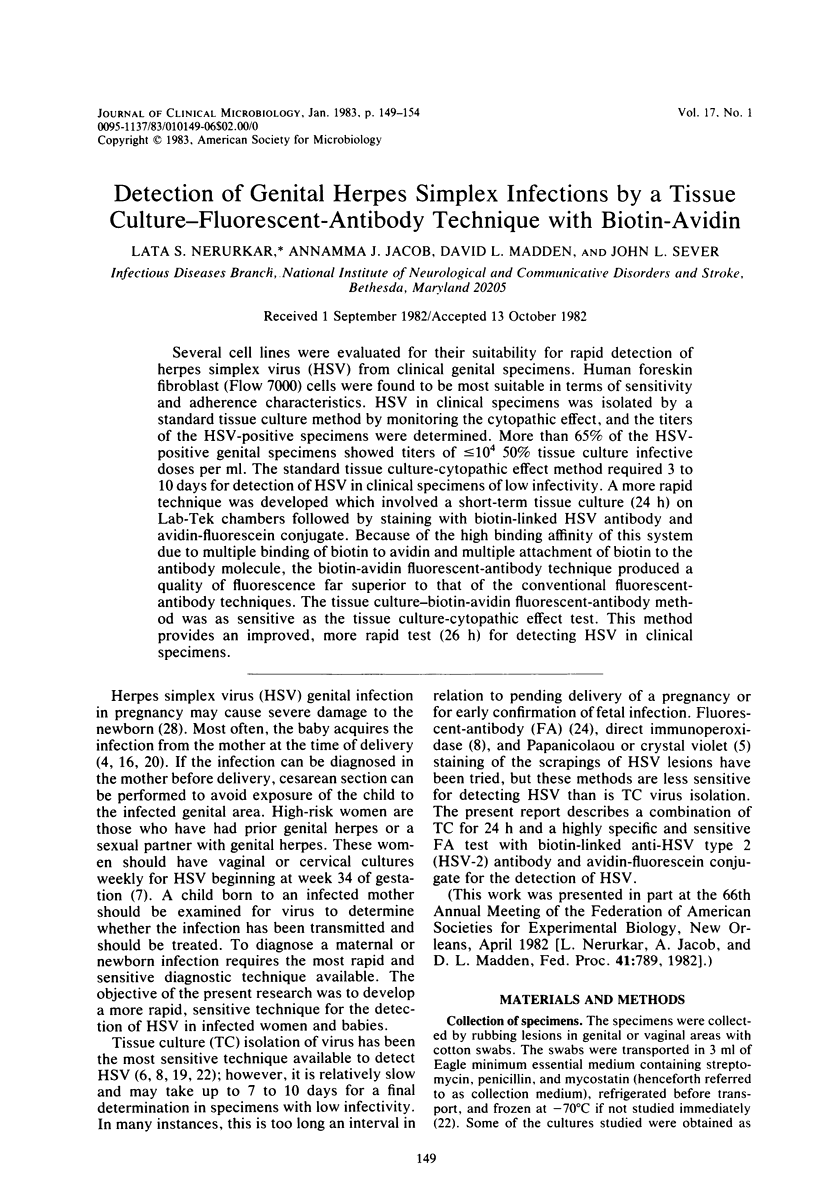Abstract
Several cell lines were evaluated for their suitability for rapid detection of herpes simplex virus (HSV) from clinical genital specimens. Human foreskin fibroblast (Flow 7000) cells were found to be most suitable in terms of sensitivity and adherence characteristics. HSV in clinical specimens was isolated by a standard tissue culture method by monitoring the cytopathic effect, and the titers of the HSV-positive specimens were determined. More than 65% of the HSV-positive genital specimens showed titers of less than or equal to 10(4) 50% tissue culture infective doses per ml. The standard tissue culture-cytopathic effect method required 3 to 10 days for detection of HSV in clinical specimens of low infectivity. A more rapid technique was developed which involved a short-term tissue culture (24 h) on Lab-Tek chambers followed by staining with biotin-linked HSV antibody and avidin-fluorescein conjugate. Because of the high binding affinity of this system due to multiple binding of biotin to avidin and multiple attachment of biotin to the antibody molecule, the biotin-avidin fluorescent-antibody technique produced a quality of fluorescence far superior to that of the conventional fluorescent-antibody techniques. The tissue culture-biotin-avidin fluorescent-antibody method was as sensitive as the tissue culture-cytopathic effect test. This method provides an improved, more rapid test (26 h) for detecting HSV in clinical specimens.
Full text
PDF





Images in this article
Selected References
These references are in PubMed. This may not be the complete list of references from this article.
- American Academy of Pediatrics. Committee on fetus and newborn. Committee on infectious diseases. Perinatal herpes simplex virus infections. Pediatrics. 1980 Jul;66(1):147–149. [PubMed] [Google Scholar]
- Baucke R. B., Spear P. G. Membrane proteins specified by herpes simplex viruses. V. Identification of an Fc-binding glycoprotein. J Virol. 1979 Dec;32(3):779–789. doi: 10.1128/jvi.32.3.779-789.1979. [DOI] [PMC free article] [PubMed] [Google Scholar]
- Bayer E., Wilchek M. Insolubilized biotin for the purification of avidin. Methods Enzymol. 1974;34:265–267. doi: 10.1016/s0076-6879(74)34023-2. [DOI] [PubMed] [Google Scholar]
- Brown S. T., Jaffe H. W., Zaidi A., Filker R., Herrmann K. L., Lylerla H. C., Jove D. F., Budell J. W. Sensitivity and specificity of diagnostic tests for genital infection with herpesvirus hominis. Sex Transm Dis. 1979 Jan-Mar;6(1):10–13. doi: 10.1097/00007435-197901000-00003. [DOI] [PubMed] [Google Scholar]
- Cho C. T., Feng K. K. Sensitivity of the virus isolation and immunofluorescent staining methods in diagnosis of infections with herpes simplex virus. J Infect Dis. 1978 Oct;138(4):536–540. doi: 10.1093/infdis/138.4.536. [DOI] [PubMed] [Google Scholar]
- Gardner P. S., McQuillin J., Black M. M., Richardson J. Rapid diagnosis of herpesvirus hominis infections in superficial lesions by immunofluorescent antibody technics. Br Med J. 1968 Oct 12;4(5623):89–92. doi: 10.1136/bmj.4.5623.89. [DOI] [PMC free article] [PubMed] [Google Scholar]
- Green N. M. Avidin. Adv Protein Chem. 1975;29:85–133. doi: 10.1016/s0065-3233(08)60411-8. [DOI] [PubMed] [Google Scholar]
- Guesdon J. L., Ternynck T., Avrameas S. The use of avidin-biotin interaction in immunoenzymatic techniques. J Histochem Cytochem. 1979 Aug;27(8):1131–1139. doi: 10.1177/27.8.90074. [DOI] [PubMed] [Google Scholar]
- Guinan M. E., MacCalman J., Kern E. R., Overall J. C., Jr, Spruance S. L. The course of untreated recurrent genital herpes simplex infection in 27 women. N Engl J Med. 1981 Mar 26;304(13):759–763. doi: 10.1056/NEJM198103263041305. [DOI] [PubMed] [Google Scholar]
- Heitzmann H., Richards F. M. Use of the avidin-biotin complex for specific staining of biological membranes in electron microscopy. Proc Natl Acad Sci U S A. 1974 Sep;71(9):3537–3541. doi: 10.1073/pnas.71.9.3537. [DOI] [PMC free article] [PubMed] [Google Scholar]
- Landry M. L., Mayo D. R., Hsiung G. D. Comparison of guinea pig embryo cells, rabbit kidney cells, and human embryonic lung fibroblast cell strains for isolation of herpes simplex virus. J Clin Microbiol. 1982 May;15(5):842–847. doi: 10.1128/jcm.15.5.842-847.1982. [DOI] [PMC free article] [PubMed] [Google Scholar]
- Light I. J. Postnatal acquisition of herpes simplex virus by the newborn infant: a review of the literature. Pediatrics. 1979 Mar;63(3):480–482. [PubMed] [Google Scholar]
- Marks M. I. Method for the preparation of a herpesvirus hominis fluorescent conjugate for direct immunofluorescence. Arch Gesamte Virusforsch. 1970;32(4):373–378. doi: 10.1007/BF01250065. [DOI] [PMC free article] [PubMed] [Google Scholar]
- Miller S. E., Lang D. J. Rapid diagnosis of herpes simplex infection: amplification for electron-microscopy by short-term in vitro replication. J Infect. 1982 Jan;4(1):37–41. doi: 10.1016/s0163-4453(82)90959-8. [DOI] [PubMed] [Google Scholar]
- Moseley R. C., Corey L., Benjamin D., Winter C., Remington M. L. Comparison of viral isolation, direct immunofluorescence, and indirect immunoperoxidase techniques for detection of genital herpes simplex virus infection. J Clin Microbiol. 1981 May;13(5):913–918. doi: 10.1128/jcm.13.5.913-918.1981. [DOI] [PMC free article] [PubMed] [Google Scholar]
- Nahmias A. J., Roizman B. Infection with herpes-simplex viruses 1 and 2. 3. N Engl J Med. 1973 Oct 11;289(15):781–789. doi: 10.1056/NEJM197310112891505. [DOI] [PubMed] [Google Scholar]
- Para M. F., Baucke R. B., Spear P. G. Immunoglobulin G(Fc)-binding receptors on virions of herpes simplex virus type 1 and transfer of these receptors to the cell surface by infection. J Virol. 1980 May;34(2):512–520. doi: 10.1128/jvi.34.2.512-520.1980. [DOI] [PMC free article] [PubMed] [Google Scholar]
- Schmidt N. J., Gallo D., Devlin V., Woodie J. D., Emmons R. W. Direct immunofluorescence staining for detection of herpes simplex and varicella-zoster virus antigens in vesicular lesions and certain tissue specimens. J Clin Microbiol. 1980 Nov;12(5):651–655. doi: 10.1128/jcm.12.5.651-655.1980. [DOI] [PMC free article] [PubMed] [Google Scholar]
- Schmidt N. J., Ho H. H., Chin J. Application of immunoperoxidase staining to more rapid detection and identification of rubella virus isolates. J Clin Microbiol. 1981 Apr;13(4):627–630. doi: 10.1128/jcm.13.4.627-630.1981. [DOI] [PMC free article] [PubMed] [Google Scholar]
- Stagno S., Pass R. F., Reynolds D. W., Moore M. A., Nahmias A. J., Alford C. A. Comparative study of diagnostic procedures for congenital cytomegalovirus infection. Pediatrics. 1980 Feb;65(2):251–257. [PubMed] [Google Scholar]
- WATKINS J. F. ADSORPTION OF SENSITIZED SHEEP ERYTHROCYTES TO HELA CELLS INFECTED WITH HERPES SIMPLEX VIRUS. Nature. 1964 Jun 27;202:1364–1365. doi: 10.1038/2021364a0. [DOI] [PubMed] [Google Scholar]
- Whitley R. J., Nahmias A. J., Visintine A. M., Fleming C. L., Alford C. A. The natural history of herpes simplex virus infection of mother and newborn. Pediatrics. 1980 Oct;66(4):489–494. [PubMed] [Google Scholar]



